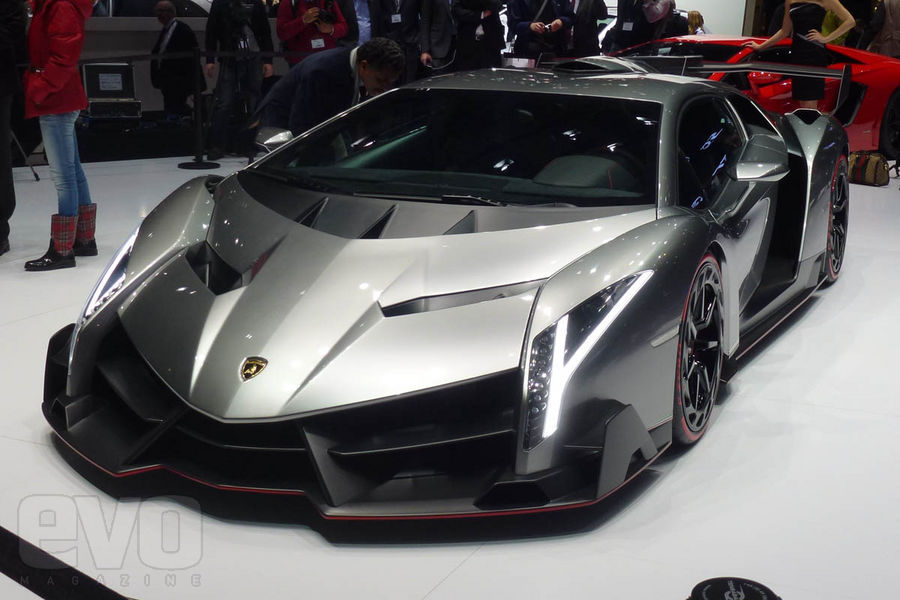Five years ago, launching a decent streaming platform took millions. Now? A teenager with a laptop can build something that reaches millions. That shift…
10 space-age cars from the 2013 Geneva Motor Show

Once a year, under one grand ceiling, all the greatest car manufacturers come together to show off their newest creations in arguably the best motor show of the year: Geneva. This year has brought the world some of the most outrageous and technologically advanced cars ever to grace the automotive industry. And many of the craziest ones are actually being built.
Porsche 911 GT3

Show a man one Porsche 911 and he’s seen them all. But that doesn’t take away from the aesthetic appeal, and the fact that after 50 Years (yes, 50) the 911 is still around is testament to this. The track-oriented GT3 is the newest 911 to the lineup, now boasting four-wheel steering. While nothing new to the motoring world, it will be great to see how it affects the GT3’s mannerisms.
The GT3 features en electronically controlled four-wheel steer system developed by Porsche’s racing and road divisions. At speeds of up to 31mph, the rear wheels will steer opposite to the front, which improves cornering speeds, while above 50mph the rear wheels turn parallel to the front, increasing stability.
And like all fancy things, it’s heavy, bringing up the total weight of the car to 1 430kg. The biggest change though, is that there will be no manual version, which no doubt will grate purist motorist’s teeth.
Ferrari LaFerrari
Probably the most anticipated revealing at the Geneva Show is this, the new Ferrari LaFerrari. Yes, Ferrari twice. Silly, I know; I think the Ferrari people are out of ideas. It’s a revolutionary car though, and not just for Ferrari.
It features a petrol-electric hybrid setup combining to produce 950bhp! That’s monumental power. On top of that, a regenerative braking system is used to recharge the batteries from braking forces and extra torque that can’t be put to the road.
On the aerodynamics front there are many tricky bits. The body has been moulded in a wind tunnel, and has had significant influence from Formula 1, including active aerodynamics. There are moveable diffusers all over the car that activate automatically depending on the speed to get, as Ferrari puts it, “the highest degree of aerodynamic efficiency ever achieved by any road car”.
But is it a looker? It’s mean, and sharp as a knife but I wouldn’t call it pretty like I would the 458 or new F12 Ferraris. Then again, few of the special production Ferraris are nice to look at at first. But I find they grow on you.
Lamborghini Veneno

Striking, isn’t it? Like it’s actually going to hit you. Sure, Lamborghini is known for outlandish cars, but this doesn’t really scream Lamborghini or Italy very much. And it does look like it will scream a lot, or at least the person inside will.
Unlike two other particular hypercars at this show, the Lamborghini Veneno only has a 6.5-litre V12 petrol engine to move it along, though it produces an impressive 740bhp. Also unlike the other guys, it doesn’t have active aerodynamics, but the whole front of the car acts like one huge aero wing and is separate from the body like a sports prototype racer would be.
So the whole approach to this car is suddenly old school. No active this, or hybrid that. Just a big old V12 and lots of cuts and channels to guide the air across the car. Oh, and the cost? There will only be three built, so probably because of that it will be €3-million plus taxes. So about three times as much as either the Ferrari or McLaren with all their fancy gizmos.
McLaren P1

Some details of the P1 have been released already about the drivetrain, but subsequently the P1 has been revealed in the flesh. And isn’t it fantastic looking! Next to the LaFerrari it is a flower next to a cleaver; and the Lamborghini Veneno looks chopped up like a stormy sea. The P1 is a breath of fresh air for the supercar design, I think; something truly different.
Underneath, though, lies the heart of a bionic dragon. It has a hybrid petrol-electric drivetrain similar to Ferrari’s, producing 903bhp. Also similar to the Ferrari are the active aerodynamics inspired by, you guessed it, F1. The giant rear wing and flaps ahead of the front wheels deploy under certain driving conditions, to produce 600kg of down-force; which is about 8 times the amount that the MP4-12C produces. So, Ferrari’s comment about the LaFerrari’s aerodynamic efficiency may be contested.
Where it differs from the Ferrari is that is doesn’t offer regenerative braking, but does offer the ability to run solely on the electric motor and a system to smooth and quicken gear shifts at speed.
Toyota i-Road

Toyota are really taking the city car seriously with this, the i-Road. It has three wheels and an incredible leaning system so you don’t fall over like when Top Gear drove a three-wheel car.
It has two seats, one behind the other like a bike. So, it technically isn’t even a car, but Toyota says it has a car-like interior.
A lean actuator called ‘Active Lean’ is used on the i-Road to balance the car during cornering. It incorporates gearing mounted above the front suspension member, connected by a yoke to both front wheels. The required degree of lean is calculated by an ECU based on the angle you steer. A gyro-sensor is used to provide the information for the ECU. Powering the i-Road is a pair of 2kW motors, one on each wheel and the battery allows for the i-Road to go about 30 miles before recharging.
It’s not even 2 500mm long and is narrow as anything, so parking is a breeze, even sharing one with another i-Road comrade. Only, the doors look quite big, so you’d need a parking almost twice the width to open them. A slight design flaw?
Alfa Romeo 4C

Possibly one of the prettiest cars ever made, the 4C is definitely going to turn heads, but surprisingly, not wallets. This is a car that has been missing from the automotive world, a small, light, carbon fibre sports car for the masses.
What sets the Alfa Romeo 4C apart from all its competition is its carbon fibre chassis. This is usually reserved only for hypercars that cost astronomical amounts of money. Besides the benefits to body stiffness, the carbon chassis also means the 4C is light. So, only with a 1 750cc 4-cylinder motor, it will have a power to weight ratio of less than 4kg for every 1bhp. This means it will weigh less than 1 000kg and no doubt be agile as a mongoose.
ItalDesign Giugiaro Parcour
Geneva wouldn’t be the same without beautiful concept cars, like the ItaliDesign Giugiaro Parcour. It is inspired by those crazy Parkour kids with all their jumping around. And it looks like an Italian muscle car; all muscle and panache.
Below that sports car cross SUV exterior is the V10 engine and all-wheel drive system from the Lamborghini Gallardo. It’s not messing around then. It even features a new pushrod-style suspension system with coils replacing the pushrods, two of which will sit on each corner. This improves the overall performance on and off-road. If only this car entered the Dakar off-road race, it would win just because it looked so good.
Koenigsegg Agera S ‘Hundra’
Let’s get straight to the facts: this is a US$1.6-million, carbon fibre and gold leaf covered, one-off Koenigsegg going to a lucky owner in Hong Kong. The whole body and chassis is carbon fibre, even the wheels, and that gold leaf, I daresay, is done very well. It took 4 000 man hours to be hand-built and it looks immaculate.
Koenigsegg is a tiny company and manages to build everything itself, while still leading the class in technology. The 5.0-litre V8 supercharged engine, for instance, has ceramic-coated pistons helping to stop irregular combustion and allowing for a higher boost pressure from the supercharger. Even the ECU and brake calipers are built in-house, the latter being asymmetrical, only being able to fit on its specific corner.
Of course, in the not too distant future we will hopefully see some truly revolutionary camshaft-less http://gearburn.com/2013/02/koenigseggs-crazy-new-camshaft-free-engine-tech/ engines coming out of Koenigsegg.
Pininfarina Sergio

The Sergio is a tribute to the leader of Pininfarina who passed away last year. And no, it’s not supposed to be driven in reverse, nor designed backwards. In fact, the Pininfarina Sergio was designed like that for a specific purpose: to show what else can be done with aerodynamics.
The magic of aerodynamics pushes the air over the cockpit, basically creating a quasi windscreen, protecting the occupants from wind forces. To counter the forces on the front end caused by the inviso-screen, a wing was placed in the front bumper to make up for the lack of aerodynamic load on the front axle.
Because there actually is no wind screen in physical form, a helmet is necessary in order to drive it. And, based on the fact that it is basically a re-bodied Ferrari 458, it’s going to be very fast.
Volkswagon XL1

A definite class leader in economic and technologically advanced materials, the VW XL1 is an astonishing piece of machinery. The features that set it apart are a carbon fibre body with a drag coefficient rating of 0.189, a 795kg kerb weight, and economy figure of 261mpg. This figure makes it the most fuel-efficient production car in the world.
The combination of a light and streamline carbon fibre body that let’s it cut through the air like a ninja and a small, frugal 800cc diesel motor mated to an electric motor, has made that figure possible. Besides the light carbon body, aluminium is used in the front and rear crash structures, magnesium for the wheels, and everything has been made as thin as possible, mostly being measured in millimeters.
The XL1 will go into limited production at the end of the year, being used more or less as a trial run, but further production plans, or even information on price is yet to be known.


